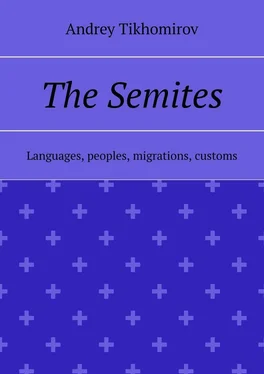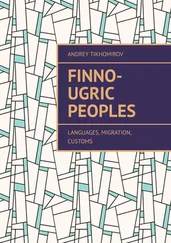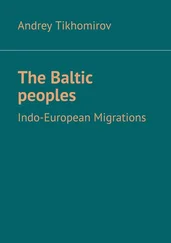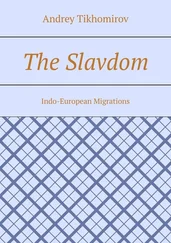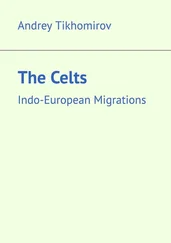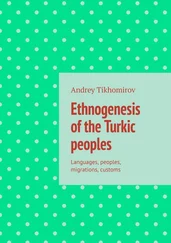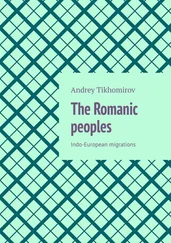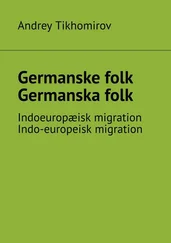Andrey Tikhomirov - The Semites. Languages, peoples, migrations, customs
Здесь есть возможность читать онлайн «Andrey Tikhomirov - The Semites. Languages, peoples, migrations, customs» — ознакомительный отрывок электронной книги совершенно бесплатно, а после прочтения отрывка купить полную версию. В некоторых случаях можно слушать аудио, скачать через торрент в формате fb2 и присутствует краткое содержание. ISBN: , Жанр: Прочая документальная литература, на английском языке. Описание произведения, (предисловие) а так же отзывы посетителей доступны на портале библиотеки ЛибКат.
- Название:The Semites. Languages, peoples, migrations, customs
- Автор:
- Жанр:
- Год:неизвестен
- ISBN:9785449823151
- Рейтинг книги:5 / 5. Голосов: 1
-
Избранное:Добавить в избранное
- Отзывы:
-
Ваша оценка:
- 100
- 1
- 2
- 3
- 4
- 5
The Semites. Languages, peoples, migrations, customs: краткое содержание, описание и аннотация
Предлагаем к чтению аннотацию, описание, краткое содержание или предисловие (зависит от того, что написал сам автор книги «The Semites. Languages, peoples, migrations, customs»). Если вы не нашли необходимую информацию о книге — напишите в комментариях, мы постараемся отыскать её.
The Semites. Languages, peoples, migrations, customs — читать онлайн ознакомительный отрывок
Ниже представлен текст книги, разбитый по страницам. Система сохранения места последней прочитанной страницы, позволяет с удобством читать онлайн бесплатно книгу «The Semites. Languages, peoples, migrations, customs», без необходимости каждый раз заново искать на чём Вы остановились. Поставьте закладку, и сможете в любой момент перейти на страницу, на которой закончили чтение.
Интервал:
Закладка:
Amhara is the main population of Ethiopia. Belongs to the Ethiopian anthropological type of Negroid race. Amharic (Amarinya) – a Semitic group, is the official language of Ethiopia; the common religion is monophysite-style Christianity. Most of the modern population of Ethiopia speaks Semitic languages, in addition to Amhara, these are tigers, gurages, argobba and harari. Amharic is a living semitic language of a significant part of the Ethiopian population, belonging to the languages of the southern group. In the Amharic language, only three parts of speech are clearly distinguished: name, verb, particle; there is no clear difference between the noun and the adjective, there is no line between the preposition and the union. The stress in the Amharic language is weak. The written Amharic language is Ethiopian with additional characters; Amharic writing and printing require 296 characters. The oldest literary monuments date back to the XIV – XV centuries. The heyday of literature dates back to the 17th century. The southern and eastern peoples of Ethiopia are Cushitic languages: galla (self-name of Oromo), which fall into two groups: Tulam and sword, or lyek; Somalia; Danakil speaking Afar; yeah; nationalities known under the general name “sidamo” (“aliens” in the Gallic language). Ethiopia is the birthplace of humanity, here, as well as throughout eastern and southern Africa, the formation of representatives of ancient humanity took place. In the valley of the lower reaches of the Avash River, many paleontological objects were found, the oldest 4 million years. The region of Tiyi was found more than 30 archaeological sites of ancient culture, whose age also reads millions of years, the valley of the lower reaches of the Omo River, where the oldest petrified remains of paleoanthropes were found. In the 1st millennium BC. the peoples of South Arabian civilization migrated to the north of Ethiopia. And from the middle of the 1st millennium BC. Until the VI century, the territory of northern Ethiopia and Eritrea was the slave state of Axum. The penetration of Christianity into Axum dates back to the 4th century. XIII century sources first mention the Ethiopian state. It comes from the ancient Greek name of the countries south of Egypt. Another name of the country and inhabitants – Abyssinia, Abyssinians, apparently, comes from the name of one of the tribes of ancient Axum – habashat. But since the inhabitants of Ethiopia (Abyssinia) see in the words “Abyssinia”, “Abyssinians” a contemptuous connotation (the Arabic word “habash” means “confusion”, “mixed people”, “mestizos”), the name of the Greek has long been accepted as the official name of the country origin – Aytyopia (Ethiopia). Despite the fact that the inhabitants of the Abyssinian Highlands speak several languages and belong to different ethnic groups, they all call themselves, first of all, Ethiopians. Ethiopians have created a rich culture that has centuries ago. They are famous for their delicate jewelry, colorful embroideries, decorating clothes, skillful weaving. From the Neolithic era in Ethiopia, dolmens, stone monoliths and tombstones with primitive images of human figures have survived. Monuments of developed art (a statue of the king and others) date back to the 9th – 7th centuries BC. The architecture of the Aksumite state, where dams, residential buildings were built, round and square in plan, reached a significant rise. Palaces (the largest of them – Takha Mariam – was divided into three courtyards, had external staircases and halls with a cruciform plan). Tombstones-stela in the form of multi-storey towers (up to 33 m high) have been preserved. With the penetration of Christianity into Ethiopia, churches and monasteries began to be built: rock churches (in Lalibela), basilicas, and small round churches.
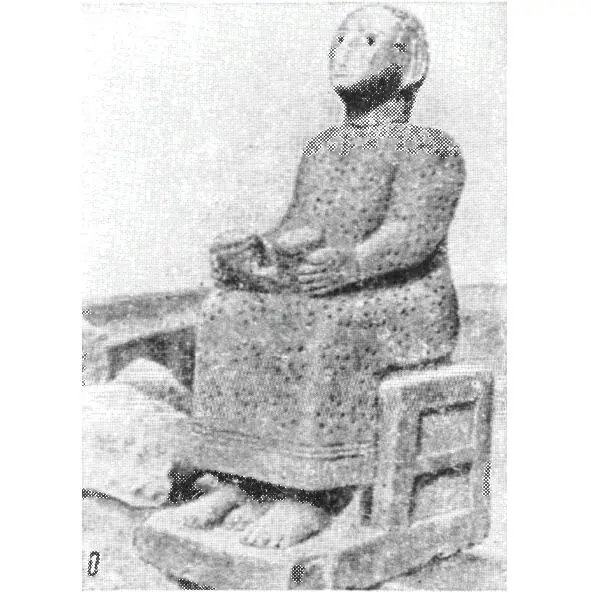
The statue of the king. 9th – 7th centuries BC. North Ethiopia

Reconstruction of the palace of Taha-Mariam. Axum
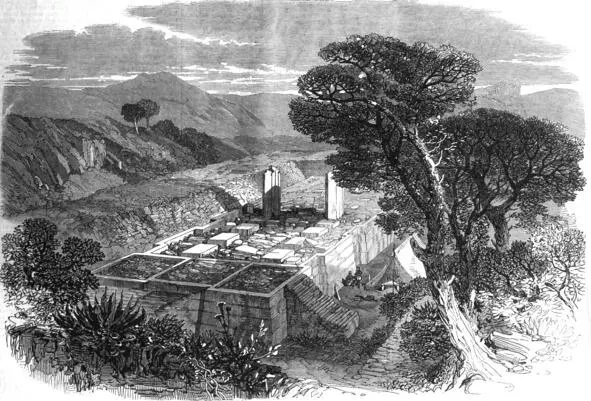
Ruins of an ancient Greek church at Agoola. (The Illustrated London News, April 11, 1868)
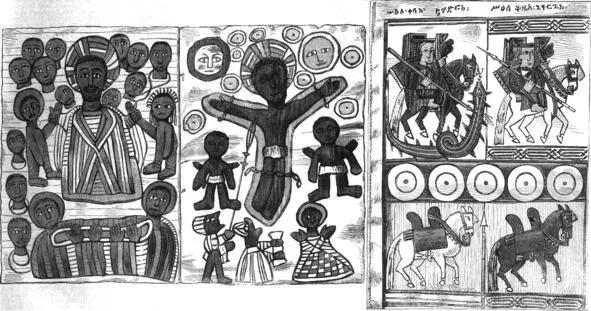
Facsimile of two pages of an Abyssinian Bible. (The Illustrated London News, March 28, 1868)

Cross used in processions. (The Illustrated London News, March 7, 1868)
Tigrai is a nation that inhabits the northern regions of Ethiopia, as well as the southern and central regions of Eritrea (northeast Africa). The language of tigrai – tigrinya, belongs to the Semitic group of Semitic-Hamitic languages. According to anthropological characteristics, tigers belong to the Ethiopian anthropological type. Religion is a monophysite Christianity. Tigre is the main ethnic group of Eritrea (northeast Africa). Inhabit the Eritrean Highlands, the surroundings of Massaua and the islands of Dahlak. According to anthropological characteristics belong to the Ethiopian anthropological type. Tigers speak the language of the tiger, which belongs to the Semitic group of Semitic-Hamitic languages. By religion, Christians. Tigers are the descendants of the population of Axum, one of the ancient slave states of northeast Africa. By language, material and spiritual culture are close to tigers. Tigre is the language of the tigers living in Eritrea (Northeast Africa), in the Eritrean Highlands, in the vicinity of Massaua and on the islands of Dahlak. Refers to the southern Semitic branch of the Semitic group of the Semitic-Hamitic family of languages.
Tigrigna is the language of the Tigrai people who inhabit the northern region of Ethiopia, the southern and central regions of Eritrea (in East Africa). Refers to the southern Semitic branch of the Semitic group of the Semitic-Hamitic family of languages.
The biblical “explanation” of the origin of mankind is explained as follows (Genesis): the sons of Noah Shem, Ham, Japheth, after the end of the “global flood” populated the whole earth, however, science proves that the flood in the area of Mesopotamia was local in nature and the sons of Noah represented the peoples there. Ham was cursed by Noah for mocking the nudity of his intoxicated father and was doomed to slavery. Shem and Japheth, who showed filial piety and covered their father with clothes, were blessed by Noah. In the biblical genealogy of Shem, Ham and Japheth, their sons and grandchildren are represented by the ancestors of the eponyms of large groups of peoples: Semitic (from the eponym Sim, peoples of Elam, Mesopotamia, Syria, Jews, etc.), rude (from Ham, peoples Africa and others) and yaphetics (“yaphetids”, from “Japheth”), identified with the Indo-European peoples. Chapter 10: “1 This is the genealogy of the sons of Noah: Shem, Ham and Japheth. After the flood, their children were born. (Three main groups of peoples living in the Middle East found their expression here: Semitic languages – Jews, Assyrians, Aramaeans, Arabs; Hamitic languages “Copts, Berbers, Amharas; Yaphet (Caucasian) languages, some scholars associate with Indo-European peoples. Although the gradation is extremely arbitrary).” Isaac Asimov writes in the book “In the Beginning” (p. 321—322): “So, after the flood, God made the earth a second time. After describing this act, biblical authors quickly organize the peoples who inhabit the world (more precisely, that part of it that was them well known) in order to go directly to the history of the Israeli tribes – the central theme of world events.The three Noah’s sons embody the ideas of the three largest groups of peoples known to the ancient authors of the Bible. It is believed that the descendants of Shem inhabit the Arabian Peninsula and areas north ofincluding the valley of the Tigris and Euphrates. Since these descendants also include Israeli tribes, Shem was honored to be the eldest son of Noah. The languages spoken by the descendants of Shem are now called “Semitic” (“Sem” is the Greek-Latin form of the Hebrew named “Shem”; in Russian transcription – “Shem.”) They include Hebrew, Assyrian, Aramaic and Arabic. According to the Bible, the descendants of Ham live mainly in that part of Africa that is adjacent to Asia. The languages of the peoples who originally inhabited this territory were called “rude”.
Читать дальшеИнтервал:
Закладка:
Похожие книги на «The Semites. Languages, peoples, migrations, customs»
Представляем Вашему вниманию похожие книги на «The Semites. Languages, peoples, migrations, customs» списком для выбора. Мы отобрали схожую по названию и смыслу литературу в надежде предоставить читателям больше вариантов отыскать новые, интересные, ещё непрочитанные произведения.
Обсуждение, отзывы о книге «The Semites. Languages, peoples, migrations, customs» и просто собственные мнения читателей. Оставьте ваши комментарии, напишите, что Вы думаете о произведении, его смысле или главных героях. Укажите что конкретно понравилось, а что нет, и почему Вы так считаете.
